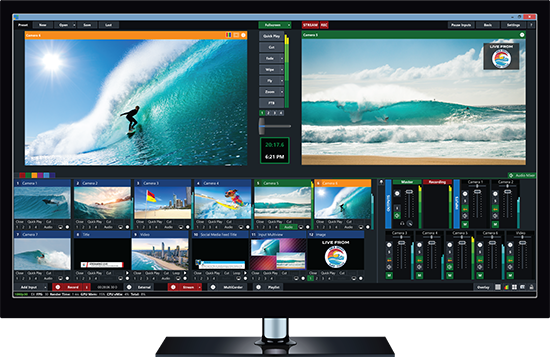Best Streaming Software for Broadcasting

From home, from the office, or even from the home office, more live streams are being broadcast today than at any other time in streaming media’s two-decade history.
One reason for this is the relative ease of software solutions through which a live broadcast can be streamed. But the choices can seem a bit overwhelming, especially to those who are new to the whole concept of streaming.
Live encoding software is essential for compressing your video feed and editing it on the fly, but the best fit depends on your unique broadcast. A wide range of streaming software can be integrated with Wowza’s full-service platform, so let’s take a closer look.
What Is Your Workflow?
The first question to think about when considering a live broadcast tool (or even a toolbox of multiple software titles) isn’t the software features. It’s the workflow in which you’ll be using the broadcast tools.
By workflow I first mean business questions about monetization as well as creative questions around the format — will it be a single-personality, single-camera approach, or will it involve in-house or remote co-hosts and guests — and the intended audience.
While these are business and creative questions, not technical ones, they still need to be answered before you choose streaming broadcast software. Otherwise you’ll spend a frustrating amount of time compromising your vision with software that wasn’t intended for the type of broadcast you want to present to the world.
At best, you’ll spend an inordinate amount of time trying to bend your technical workflow to your creative one, and more than likely you’ll give up in frustration without realizing you needed a “wrench” when all you had was a “hammer” at your disposal.
Once you’ve addressed the business and creative workflow questions, then it’s time to turn your attention to the proper software tools for the job. Since there’s not a one-size-fits-all approach to live streaming broadcasting, we’ll use a few examples of typical broadcast scenarios.
One to Many
If you’re doing a solo broadcasting gig, there are a wide set of options, mostly differentiated by the level of production value and number of cameras.

For instance, if you just want to broadcast an event from a single, stationary camera, there are a number of software applications for your Android or iOS smartphone or tablet that can do the trick. You’ll probably be unable to do lower-thirds graphics (titles at the bottom of the screen) or crawls (a ticker-type band at the very bottom of the screen with key information or breaking news) using these applications, but you will be able to broadcast live to a reasonably sized audience with no more effort than naming your stream and clicking the “broadcast” button.
Here’s a personal example: I got married about two days before the start of the COVID-19 self-isolation mandates. Since we’d had friends and members of the wedding party from abroad who couldn’t attend due to border closings, we proactively disinvited a number of our elderly or immuno-compromised friends and began searching for a way to stream the ceremony.
Working in the streaming industry doesn’t necessarily make it easier to think through the workflow of something as important as your own wedding, but my fiancée and I were looking for an easy-to-implement option that didn’t require much configuration or headache. We considered Facebook Live and a few social media live-streaming apps, but didn’t want to limit viewing to those with accounts. We ultimately went with IBM Video Cloud after an industry friend offered a temporary account.
This worked well for our one-to-many broadcast. That said, it might not have been our one-stop solution if we were looking for real-time interactivity and advanced mixing.
Many to Many
Let’s say you want to do a similar spartan setup, but with two co-hosts at different locations, or a remote guest. In this instance, you need not just your camera and local software but also a similar set-up for the remote host or guest(s) to interact with you and to also be captured as part of the live event stream.
One way to accomplish this is through a basic video conferencing tool like Zoom — which has absolutely exploded in popularity with the average user during the pandemic lockdowns, perhaps because so many work-at-home users were already familiar with it from enterprise deployments — but there are other solutions out there that are geared towards more than just a Hollywood Squares multi-window approach and screen sharing.
Media Platform has a software solution that’s not only browser-based (requiring no separate app download like Zoom does) but also has extensive controls for remote guests and audience members.
Other web conferencing tools that are being repurposed into live event broadcasting include Apple’s FaceTime, Google Meet, Microsoft Teams, Pexip, Skype, Webex, and Whereby.
Each has an easy-to-use multi-window environment and screen-sharing, some have chat and limited moderation options, but few have true broadcast workflow focused options. That said, it’s possible to combine these platforms with a professional-grade server software for large-scale streaming without any prior video experience.
Adding to the Mix
To get to a broadcast-level workflow that includes lower-thirds graphics, picture-in-picture (for over-the-shoulder newsroom visual layouts), pre-recorded content playback, crawls and logo (bug) insertion, you’ll need to consider a set of tools geared towards these features.
The range of tools in this category are fairly limited, especially if you’re looking for just software solutions. If you want to buy a hardware-software combination, with multiple local camera inputs to cover multiple camera angles, you can go up to the NewTek TriCaster line or even a streaming-specific broadcast hardware solution like those sold by ATEN, Livestream, LiveU, or Teradek.
On the software front, there are three tools that I’ve used and can recommend.

The first is vMix, a company I spotted at a very small booth at NAB 2013 while scouting for the inaugural Streaming Media magazine Best of NAB award. The software has come a long way from that time, when it was just Martin Sinclair showing off the features on his laptop, and is now a true broadcast software that’s still quite reasonably priced. It’s designed to run on a laptop, but robust enough to scale from a laptop to purpose-built hardware. The vMix software comes in a variety of use-case-specific versions, including vMIX Churches for houses of worship. This switcher is a popular option for broadcasters looking to feed professional-quality video productions into streaming services like Wowza Streaming Cloud.
The second, Wirecast Pro, is a software-based broadcast solution offered by Telestream. There’s a non-pro version as well, but I’ve found the Pro version useful enough for graphics, screen grabs, and even audio mixing, that we use it (and detail our use of it) on the monthly industry live webcast called SM Advanced Forum (SMAF for short) that includes four remote co-hosts and at least two remote guests, plus titles, bumpers, bugs, and lower-thirds graphics. And Wowza tells me that Wirecast pares well with their suite of streaming technology — with documentation available for both Wowza Streaming Cloud and Wowza Streaming Engine.
A final software solution, one that’s free and was used extensively on SMAF back when we first started in 2018, is an open-source tool called Open Broadcaster Software (although everyone calls it by its acronym, OBS). The freely available OBS Studio software has a number of key broadcast features. Although it’s a bit limited with virtual camera options, the open-source nature of OBS means that its feature set is constantly growing. Video tutorial are available for integrating OBS with Streaming Cloud and Streaming Engine.
How Much Firepower?
One word of caution on all these robust audio-graphics-vision mixing software tools for live broadcasting: they consume a significant amount of processing power.
It’s understandable, given the fact that GPU and CPU are being enlisted to not only handle multiple virtual inputs, apply graphic overlays, and mix audio, then encode it all and link it to a social media or online video platform.
I strongly recommend dedicating a laptop with a power connection or even a spare desktop to act as a central broadcast hub. Screenshare or broadcast your camera from another location.
One trick we’ve found with SMAF, now that Hangouts with its lower-thirds and other broadcast tools has been deprecated, is to allow the dedicated broadcasting computer to join the Zoom or Meet as a participant, then screen capture the Zoom or Meet as a single camera input into OBS or Wirecast.
This significantly lowers the processing burden, but does make for a bit of logistics work if lower-third graphics are used for participant naming. So, we tend to use the lower-third graphic only during an introductory portion of the web broadcast, as each host or guest is introduced, then switch it off for the freewheeling portion of the hour.
It’s a Wrap
Hopefully, even though I’ve only highlighted a few use cases for live streaming broadcasts, you’ll find enough guidance from the one-to-many and many-to-many highlights to be able to pick a direction for your own live-event broadcasts.
Feel free to reach out to me or the Wowza team with questions, from the simple to the rather complex, and we’ll either answer directly or point you towards professional services that handle live events at scale. Happy streaming!




